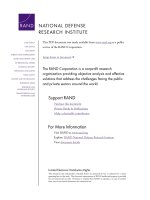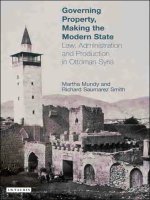Governing property, making the modern state Law, administration and production in Ottoman Syria pdf
Bạn đang xem bản rút gọn của tài liệu. Xem và tải ngay bản đầy đủ của tài liệu tại đây (5.11 MB, 321 trang )
Governing property, making the modern state
martha mundy & richard saumarez smith
Governing property, making
the modern state
Law, administration and production in
Ottoman Syria
v
Contents
Maps, figures and tables |viii Note on transliteration,
datation and abbreviation | x Acknowledgements | xii
1 Introduction . . . . . . . . . . . . . . . . . . . . . . . . . . 1
Two documents. . . . . . . . . . . . . . . . . . . . . . . . . 1
Persons and things . . . . . . . . . . . . . . . . . . . . . . . 2
Part one Ottoman jurisprudence concerning ownership of
agricultural land . . . . . . . . . . . . . . . . . . . . . . . . 9
2 Jurisprudential debate in the sixteenth century . . . . . . . . . 11
Classical Hanafi doctrine on the character of property in land. . . . . 11
Hanafi doctrine under the Mamluks . . . . . . . . . . . . . . . 12
The readings of Ottoman jurists . . . . . . . . . . . . . . . . . 13
3 Jurisprudential debate in the seventeenth and eighteenth centuries 21
The powers and properties of the administrator . . . . . . . . . . 23
The legal persona of the sahib al-ard | 23 Tax collection
and land administration: the village and the tax farmer | 25
The powers and properties of the cultivator . . . . . . . . . . . . 28
The nature of the cultivator’s right | 28 The legal person of
the cultivator | 31
Conclusions . . . . . . . . . . . . . . . . . . . . . . . . . 37
4 Legal reform from the 1830s to the First World War . . . . . . . 40
The character of Ottoman reform . . . . . . . . . . . . . . . . 41
1830s–40s: law as programme . . . . . . . . . . . . . . . . . . 43
Regional government |43 Land law | 44
1850s–60s: law as blueprint for institution . . . . . . . . . . . . . 45
A Damascene excursus | 48 Administrative consolidation | 50
After the 1870s: law as political administration of private property . . . 51
Part two The administration of property in one district of
the empire . . . . . . . . . . . . . . . . . . . . . . . . . 53
5 Production and settlement in the district of `Ajlun . . . . . . . . 57
vi
6 The introduction of bureaucratic registration . . . . . . . . . . 66
Indirect rule and the political economy of the region. . . . . . . . . 66
The beginning of title registration . . . . . . . . . . . . . . . . 68
Yoklama registration . . . . . . . . . . . . . . . . . . . . . 70
Registration of land in shares . . . . . . . . . . . . . . . . . . 73
7 Regional leadership and the prosecution of a governor. . . . . . 80
Background to the case. . . . . . . . . . . . . . . . . . . . . 80
The depositions. . . . . . . . . . . . . . . . . . . . . . . . 81
The charges and appeals . . . . . . . . . . . . . . . . . . . . 88
The properties of regional leaders . . . . . . . . . . . . . . . . 90
‘Abd al-Qadir Efendi Yusuf al-Sharaida of the Kura | 90
Ibrahim Sa‘d al-Din and Muflih al-Jabr of the Kafarat | 93
8 Property and administration in the later Tanzimat . . . . . . . . 96
The 1880s and the Special Commission for the Lands of Hauran. . . . 96
Administrative development in the 1890s and beyond . . . . . . . . 99
Conclusion . . . . . . . . . . . . . . . . . . . . . . . . . 101
Part three Governing property: administration, village,
household. . . . . . . . . . . . . . . . . . . . . . . . . . 105
9 Registration and political economy in two plains villages . . . . . 108
Bait Ra’s . . . . . . . . . . . . . . . . . . . . . . . . . . 108
Hasan al-Sabbah’s group | 109 1880 tapu registration | 111
1895 tax registration | 117 New landholders in 1895 | 118
Marriage links between new families | 119 The resettlement
of 1921 | 122 Transfers of land between 1880 and 1921 | 125
Conclusion: title or tax, groups or individuals? | 126
Hawwara . . . . . . . . . . . . . . . . . . . . . . . . . . 127
Unsettledness: initial registration in Hawwara, 1876–83 | 129
Title versus tax: regularization of entitlement in 1921 | 135
Mutations of the 1895 tax register in line with title | 138
Extent of landless population in Hawwara, 1895 | 140
Landholdings in the 1895 tax register | 141 The pattern of
field holdings in 1895 | 143 Land allotment in 1933 | 149
10 Registration and political economy in two hill villages . . . . . . 152
Kufr ‘Awan. . . . . . . . . . . . . . . . . . . . . . . . . . 153
Holdings of musha‘ land in 1884: allotment by zalama | 156
Composition of village sections | 163 Women’s claims to land,
1884–1939 | 167
vii
Khanzira (present Ashrafiya) . . . . . . . . . . . . . . . . . . 177
Production and property in 1884 | 177 The role of tax registration
in 1895 | 183
11 A village of the plains: Hawwara . . . . . . . . . . . . . . . 186
Farming in Hawwara . . . . . . . . . . . . . . . . . . . . . 186
Life histories . . . . . . . . . . . . . . . . . . . . . . . . . 188
‘Abdul-Rahman Mahmud Ahmad al-Mustafa Tannash | 188
Khadija ‘Abdullah Muhammad ‘Abdul-Rahman al-Jammal | 191
Muhammad Khair Khalil Mustafa Taha al-Shar‘ | 197
General observations . . . . . . . . . . . . . . . . . . . . . 200
The household of Na’il Ibrahim al-Gharaiba . . . . . . . . . . . . 202
The other branches of the Gharaiba . . . . . . . . . . . . . . . 204
12 A village of mixed agriculture in the hills: Kufr `Awan . . . . . . 208
Farming in Kufr ‘Awan . . . . . . . . . . . . . . . . . . . . . 208
Life histories . . . . . . . . . . . . . . . . . . . . . . . . . 210
Husna Salih Hamdan: farming in the village | 210 Ahmad Khalifa
Sa‘d al-Ahmad: wage labour, cattle herding and farming | 214
Family histories of Hasan and Husain ‘Abdul-Rahman ‘Amaira | 217
Ni‘ma Muhammad Mahmud al-‘Abid: cattle raising | 217 Mahmud
Ibrahim Husain al-‘Abdul-Rahman: breeding cattle and horses | 219
‘Ali Qasim ‘Awad al-Mustafa: spirituality and goat herding | 223
Yumna Mustafa Nimr al-Muflih: a farming family | 227
13 Epilogue . . . . . . . . . . . . . . . . . . . . . . . . . . 233
Notes. . . . . . . . . . . . . . . . . . . . . . . . . . . . 237
Bibliography . . . . . . . . . . . . . . . . . . . . . . . . 289
Index. . . . . . . . . . . . . . . . . . . . . . . . . . . . 299
viii
Maps, figures and tables
Maps
5.1 The district of ‘Ajlun in regional context 56
5.2 The district of ‘Ajlun: topography and nahiyes 58
5.3 Villages of the district of ‘Ajlun 59
5.4 Land use 60
5.5 Total number of houses 61
5.6 Average value of houses in village 62
5.7 Houses: total taxable value 63
6.1 Registration of villages 69
6.2 Land values 76
6.3 Type of landholding 78
Colour plates
9.1 Hawwara: allotment of fields to shareholding sections in 1933
1o.1 Kufr ‘Awan: allotment of fields to shareholding sections in 1939
Figures
6.1 Arabic document concerning the lands of the village of Makhraba 74
7.1
Musha‘ landholdings of the Sharaida family in Tibna, 1883 92
9.1 Bait Ra’s, households of Hasan al-Sabbah’s family and affines in 1910 120
9.2 Bait Ra’s, households of the ‘Uwaida family and affines in 1910 121
9.3 Hawwara, genealogy of the Gharaiba families with shares in 1895
and 1933 133
9.4 Hawwara, holdings of the Abu Kirsanna family, 1876–95 134
9.5 Hawwara, field allotment of the Gharaiba half in 1895 146
10.1 Kufr ‘Awan, households of families 28 and 29 in 1910 160
10.2 Kufr ‘Awan, households of family-2 in 1910 162
10.3 Kufr ‘Awan, households of family-6 in 1910 169
10.4 Kufr ‘Awan, sequence of inheritance of one share in family-10,
1884–1931 170
10.5 Kufr ‘Awan, households of families 9 and 10 in 1910 171
10.6 Kufr ‘Awan, shares of family-10 in 1939, showing holdings of women 172
11.1 Tannash family holdings in 1933 189
11.2 Jammal family holdings in 1933 192
11.3 Marriage relations of the Abu Tair family 195
11.4 Shar‘ family holdings in 1933 198
11.5 Gharaiba intermarriages in the upper generation 203
ix
11.6 Ahmad ‘Abid-Rabbuh’s descendants and their shares in 1933 205
11.7 Holdings of ‘Abdul-Ghani al-Shahada’s descendants in 1933 207
12.1 Family links of Husna Salih Hamdan 211
12.2 Marriage links of Ahmad Khalifa Sa‘d al-Ahmad 215
12.3 Family links of Ni‘ma Muhammad Mahmud al-‘Abid 218
12.4 The marriages of Ibrahim Husain ‘Abdul-Rahman 221
12.5 The children of Sheikh ‘Awad 225
12.6 Family links of Yumna Mustafa Nimr al-Muflih 229
Tables
9.1 Bait Ra’s, complete holdings 1880, 1895 and 1921 112
9.2 Bait Ra’s, landholdings by families 1880, 1895 and 1921 124
9.3 Hawwara, landholdings in 1876 and their history to 1895 130
10.1 Kufr ‘Awan, properties of
musha‘ shareholders in 1884 157
10.2 Khanzira, share per person and per holding in 1884 179
x
Note on transliteration, datation and abbreviation
Transliteration
When citing from documents and archival sources, transcription follows
the language of the source: Arabic transcription when from text in Arabic and
modern Turkish forms when from Ottoman Turkish. As a result, two spellings
may be found in the text for technical terms; both are given in the relevant entries
of the index. Terms originally Arabic or Ottoman Turkish but naturalized in
English are spelt as in the Oxford English Dictionary, with the exception of
effendi, spelt throughout as efendi. Choices have had to be made when discussing
terms in the text and not citing directly from documents. In general, in passages
about the villages, terms that are Arabic in origin and meaningful also to the
villagers are spelt in Arabic transcription; terms that are Turkish in origin are spelt
as Turkish. Likewise in Chapter 7 where a document translated from Arabic into
Turkish is cited, Arabic words not common in Ottoman Turkish are transliterated
as Arabic in quotation marks. In single transliterated words, neither the Arabic
nor the Turkish plurals are used, but an s as in the English plural is added to the
transliterated word. In Part three the abbreviation q, standing for qirat/carat, is
also used.
In Parts one and two Arabic names follow the ordinary conventions whereby
a personal name is followed by a father’s and grandfather’s personal names, with
or without the indication ibn, ‘son of’. In Part three following village usage the
definite article is often employed with an ascendant’s name, e.g. Ahmad al-Mus-
tafa. Although marks indicating vowel length are not generally given, where there
is a danger of confusion between two names, long marks are used.
Datation
In this study three calendar systems appear: the Gregorian (common Christian
era), the hijri (AH), and the Ottoman financial (mali) calendar (AM). The
Ottoman financial calendar was a solar system beginning on 13 March of the
Gregorian calendar. The common Christian era is used as a chronological base.
According to the datation of the source, either the hijri (AH) or the Ottoman
mali (AM) date is given; and the spelling of the months depends on the language
of the source, Turkish or Arabic.
Abbreviation
The following Turkish conventional abbreviations for the hijri months are
used in footnotes:
M Muharrem/Muharram
xi
S Sefer/Safar
Ra Rebiyülevvel/Rabi‘ al-awwal
R Rebiyülahir/Rabi‘ al-akhir
Ca Cemaziyelevvel/Jumada ’l-awwal
C Cemaziyelahir/Jumada ’l-akhir
B Recep/Rajab
Ş Şaban/Sha‘ban
N Ramazan/Ramadan
L Şevval/Shawwal
Za Zilkade/Dhu ’l-Qa‘da
Z Zilhicce/Dhu ’l-Hijja
Abbreviated codes are utilized for archival and manuscript sources in the
footnotes; these are explained in the bibliographical sections on archival and
manuscript sources.
Lastly, the following abbreviations are occasionally employed for kin relations:
F (father), M (mother), B (brother), Z (sister), H (husband), W (wife), S (son) and
D (daughter). For the conventions used in genealogical figures see Laslett (ed.),
Household and Family in Past Time (1972), pp. 41–2.
xii
Acknowledgements
We have accumulated many debts during the research and writing of this book.
The study was made possible by research affiliation with the Institute of
Archaeology and Anthropology of Yarmouk University, Jordan, 1989–92. The
Irbid and Amman Department of Lands and Surveys, the Irbid Civil Court, Civil
Registry and Tax Department, the Yarmouk University Research Centre, and
the Jordan University Library Special Collections all shared their documents
with us. The municipal authorities of the villages of Bait Ra’s, Hawwara, Kufr
‘Awan and Ashrafiya welcomed us, as did many of the village residents. Special
thanks are due to Ghassan al-Sharaida, Hasan ‘Ababna, Husam ‘Azar, Hala
Hijazain, Sari Fanik and Kamil Nasrawi of the DLS; to Lucine Taminian, ‘Adil
al-Zu‘bi, Ahmad Jaradat, and Maisun and Maisara al-Zu‘bi (of Sirin) in Irbid; to
academic colleagues Mu‘awiya Ibrahim, ‘Adnan al-Bakhit, Naufan al-Hamoud,
Cherie Lenzen, Seteney Shami, Hind Abu ’l-Sha‘r and Ayman al-Sharayda; and to
all those of the villages of Tibna, al-Taiba, Hawwara, Bait Ra’s, Kufr ‘Awan and
Ashrafiya who shared their memories with us. Some of these men and women
are named in Chapters 9–12. Special thanks are due to Umm Jamal and the late
Abu Jamal Muhammad Falih Ibrahim Khashashna, Umm Hashim and the late
Abu Hashim Budaiwi Mustafa Mufaddi Gharaiba, and ‘Abd al-Hafiz Hamid
Musa Salama Shatnawi. We ask their forgiveness for any errors they may find in
our rendition of their personal, family and village histories. This work is but our
interpretation; the history belongs to them.
In Damascus special thanks are due to Abdul-Karim Rafeq who first suggested
work on the fetwas of the Damascus muftis in the Zahiriya Collection; to aca-
demic colleagues Faisal ‘Abdullah, Khairiya Qasimiya and the late Nazim Kallas;
to Amira Burniya and successive directors of the Asad Library; and to the Syriac
Catholic Bishopric for its generous reception.
In Istanbul work was possible thanks to the staff of the Prime Ministry
Archives and of the Millet, Bayezit and Süleymaniye Libraries, and to the hospi-
tality of the American and Swedish Research Centres. Special thanks to Necati
Aktaş for his gracious welcome.
In Beirut thanks are due to colleagues in the History Department and the
Library staff of the American University of Beirut, and to Akram Jamal al-Din
for help with page layout.
Lastly, thanks to Ottomanists who suffered our intrusion: Halil Sahilloğlu,
Marc Aymes, Laurent Mignon, Suraiya Faroqhi, Colin Imber, and most particu-
larly Engin Akarlı.
Anne LeFur drew the maps in Paris, Michael Howley edited the prose in New
xiii
York, and in London Neslihan Abdurrazak corrected our transcription of Turk-
ish, and Ewan Smith designed and set the book.
Financial support came from many sources: the Wenner Gren Foundation
(1989), UCLA Kerr Fellowship (1989–90), the Social Science Research Council
(1990–91), the Centre d’Etudes et de Recherches sur le Moyen Orient Contemporain
(1992), the British Institute of Archaeology and History (1992–93), the Wissen-
schaftskolleg zu Berlin (1995–96), the Council of American Overseas Research
Centres (1996–97), the British Academy (2000–2002), the London School of
Economics and the American University of Beirut. Finally, thanks to Jack Goody
for his practical help and his unflagging intellectual curiosity about property.
1 | Introduction
Two documents
al-rub‘a wa-nisf ard
ghurush
miri
Court of First Instance, ‘Ajlun, dated 27 Shubat 1297
AM [11
March 1882].
halit ve
şeriktapu
halit ve
erik
Introduction | 1
Persons and things
personae
tapu
tapu hijri
personae
tapu
personae
halit ve şerik
Introduction
tapu halit ve şerik
Tanzimat
Tanzimat
tapu
Introduction | 1
4
but the first where property was represented as shares in village land. In the two
villages registered before Hawwara descriptions of the borders of the separate
plots of land of each owner had been entered in the register. The apparent in-
novation, which was thereafter widely adopted across the district, resulted from a
kind of political settlement. In this, officers of the state met regional and village
leaders to negotiate the representation of rights in land in accordance with the
law, the techniques of registration, the character of tax accounting, and the social
organization of production on the ground.
Individual property rights were constructed at the intersection of law, adminis-
tration and production. The three parts of this book consider these in turn. With
regard to law, the nineteenth-century Tanzimat reforms are not a failed attempt at
Western legal modernization. Nor are they simply a by-product of the imposition
of a world market. Rather the reforms, transforming legal vocabularies from within
Ottoman tradition, sought to respond to the competitive world system.
10
Law is constructive; doctrine matters. But following Wittgenstein, there is
no straightforwardly meaningful rule; meaning arises from interpretation. In
the nineteenth century, interpretation was not an effect of pure doctrine but of
an increasingly powerful administration of interpretation. Thus, the antinomy
between law and governmentality sketched by Foucault is best taken as rhetorical,
resting on an elegant but excessively narrow vision of law as God’s and the Prince’s
command.
11
Law did not give way to specialized techniques of government in the
nineteenth century; rather, it became increasingly bound up with administrative
formalization.
In this study we examine the forms of registration and cross-referencing of
persons and objects introduced by the Tanzimat reforms. Such processes of regis-
tration can be interpreted as part of systems of power-knowledge in the manner
sketched by Foucault and developed subsequently in studies of ‘governmentality’.
But we go beyond ‘discourse’ to consider the political context of the production
of entries in particular registers and the consequences of registration for the social
agents appearing in the grids. Such analysis works against the ‘dissolution of the
subject’ characteristic of discursive analyses of power-knowledge. Government
registers were forms filled out by identifiable agents, institutional and political,
acting at two administrative levels: the district and the village. The methodology
adopted here moves back and forth: from a reading of the systems of registration
to a reconstruction of relations captured by that lens. Thus, through the filter of
the register something of the ‘local knowledge’ concerning right-holders in agri-
cultural production can be discerned. As this implies, the processes of agricultural
work, domestic labour and childbearing entail a density of social knowledge and
exchange distinct from their partial representation in the registers. Hence, in Part
three, different kinds of sources are drawn upon to portray the interaction of
village men and women with state administration and the character of property
relations in particular villages and in individual families.
And so, before we leave the case with which this chapter opened, let us briefly
place the parties to the dispute in the context of Hawwara’s political economy.
Introduction
bedel-i misl
müşterek
dönüm
tapuhalit ve şerik
tapu
Introduction | 1
halit ve şerik khalit wa-
sharik
khalitsharikkhalit
sharik
khalit
sharik
halit ve şerik
miri
Mecelle
mülk
mülkmiri
miri
mülk
Mecelle
halit
şerik
halit
tapu
wakil
Introduction
tapu
tabula rasa
miri
chef-lieu
Introduction | 1
8
does so without dissolving the agency of regional elites. Negotiation, translation
and conflict, not simply imposition, marked the process of governmental change.
The regional elites mediated the demands of central government with the social
dynamics of agricultural production and village reproduction, the third moment
of property in our analysis.
Part three documents in detail the registration of property in four villages.
The four villages belong to two distinct systems of production: the Haurani
plain where market-oriented production of wheat and lentils dominated village
economies, and the Kura foothills, where village agricultural production was only
partially integrated into the market, and livestock provided the major source of
cash income. In Part three systematic differences in the forms of actual right
are seen to correspond to differences in the two systems of production. Lastly,
micro-level analysis of household organization reveals how the object of property,
land, was effectively a different ‘thing’ in the two village systems, and hence why,
the law notwithstanding, women came to accede to such property in one system
whereas they were almost entirely excluded in the other.
PART ONE | Ottoman jurisprudence concerning
ownership of agricultural land









